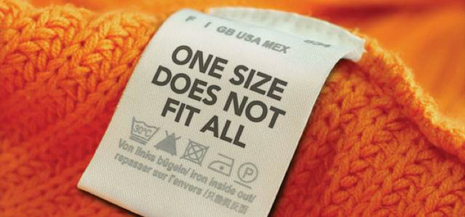
Thread Flair: The vanity of vanity sizing
Violet‘s favourite fashionista Ellie Mullett berates the perils of misleading labels

People come in all shapes and sizes, so of course one size doesn’t fit all. But your body doesn’t change every time you walk out of one shop and into another: so why might you comfortably fit into a size 12 from one brand and just about squeeze into a 16 in another?
This is the world of vanity sizing, where some clothes are deliberately labelled with a smaller size, supposedly to make customers feel better about themselves. It could be an attempt to standardise clothing sizes to match modern-day requirements as well as a marketing ploy. Yet, when taking multiple sizes of the same item into the changing rooms has become second nature because there’s no way of knowing which is going to be the best fit, then the attempts to introduce vanity sizing can seem, well, vain.
There is no doubt that the standardisation of sizing has to be altered as people evolve. Marilyn Monroe infamously wore a size 14 while she was alive, but today she would be swamped by an outfit of the same size and would fit much better into a contemporary size 8.
Over the past century, the average height of women has increased by 4 inches, and the average waistline from 20" to 33". Manufacturers would struggle to sell any clothes if they still assigned the same measurements to the same labels, since few would fit into them. When standardisation is far from standardised, though, we are still left scratching our heads at what size we actually are.
“Both vanity sizing and its antithesis create far more problems than they do subtle flattery.”
A quick comparison of size guides online found almost an inch between what different stores consider to be a size 14. ASOS and Marks & Spencer are two of the more generous retailers, with a size 14 waist measuring at 31.5” and 31.75” respectively, yet in Zara, a size 14 measured almost an inch less, at 30.7”.
An inch might not seem like very much, but it could mean the difference between one size and the next. When some consumers avoid the shops where they can’t fit into what they consider to be a desirable size, then such a tiny measurement becomes a much bigger problem for our image-obsessed society.
On the other hand, stores can undersize with equally bad effects. Last month I ordered two pairs of near-identical size 10 jeans from Topshop. When they arrived, and the first didn’t fit as well as usual, I measured the waist and found it to be two inches smaller than advertised. Topshop assured me over email this was a fault with this particular batch of jeans, which I might have believed, had the other pair not then measured up as actually being a size 6. The allowance for margin of error means no two garments will ever be precisely the same. But when there is a spectrum of measurements within the same store, there is a real potential to damage the self-esteem of young women, who may be highly susceptible to careless labelling.
The rational shopper will realise that a label is just that: what is important is whether an item of clothing suits you, makes you feel confident, and is comfortable to wear, not what number features on the label. But a materialistic society is rarely a rational society. Both vanity sizing and its antithesis create far more problems than they do subtle flattery. It’s about time manufacturers realised that it would mean just as much to us to be able to pick up one size from any store, taking it home knowing it will fit, than it does for our egos to be flattered with a misleading label

